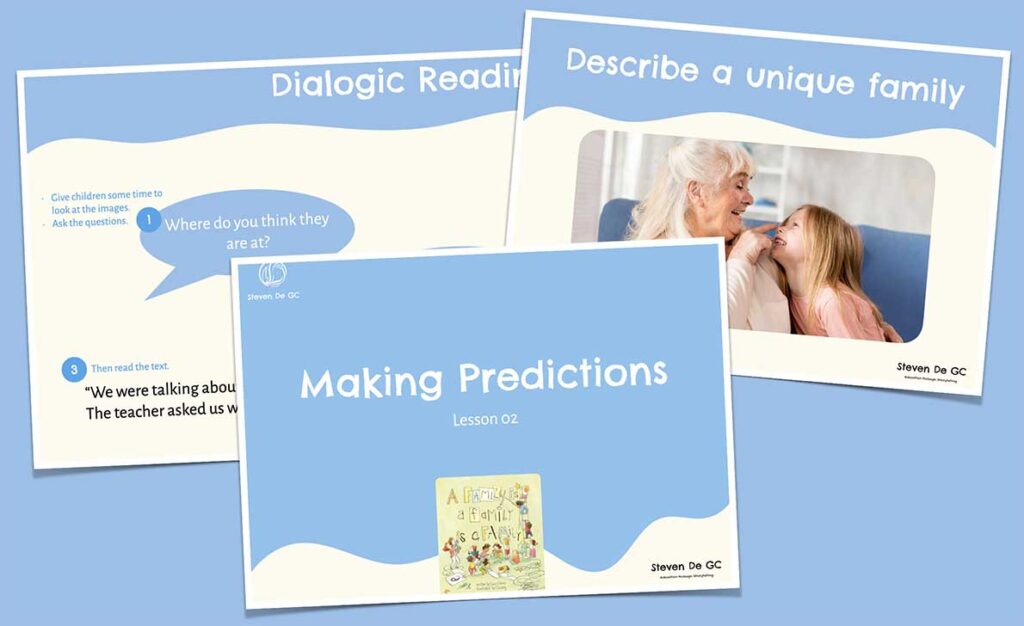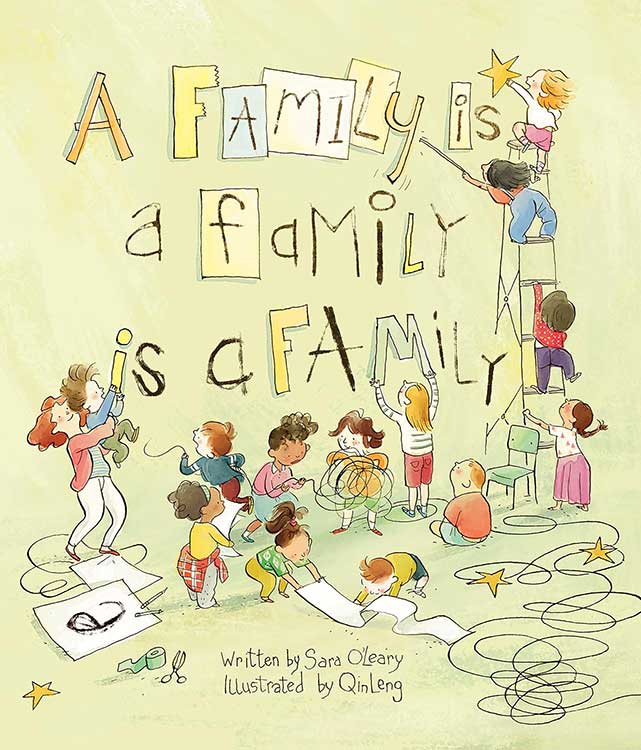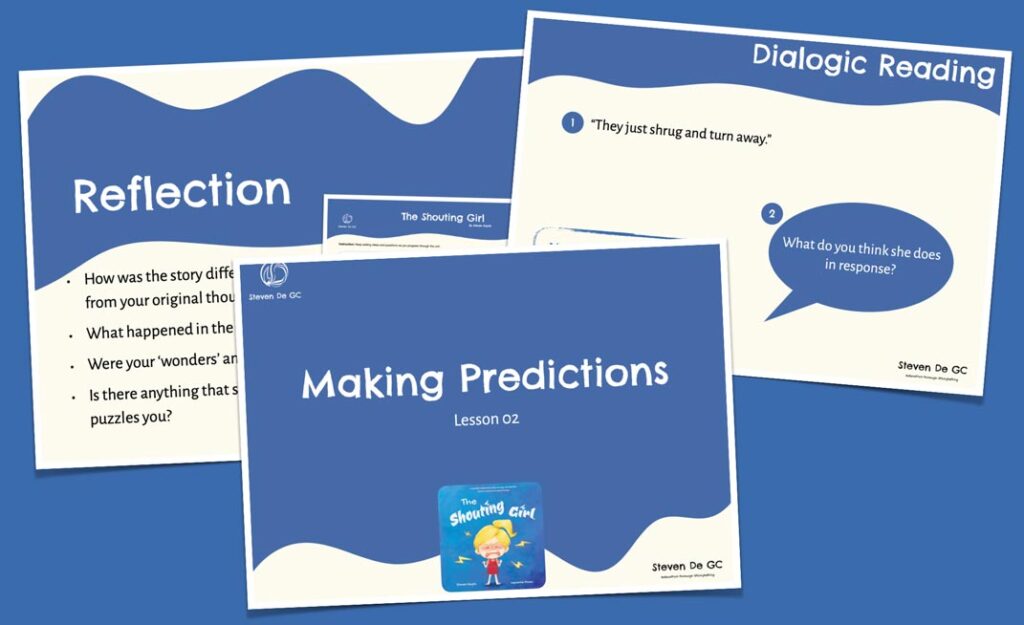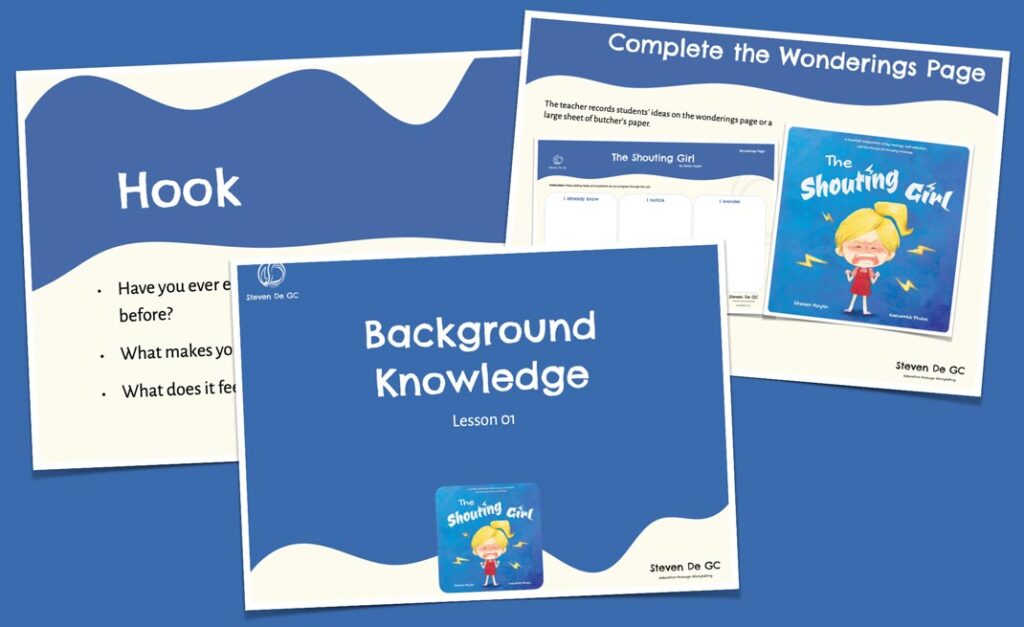- Review
- Revisit the Wonderings page with students to remind them of their ideas and predictions.
- Dialogic Reading
- Model fluent reading with expression and intonation.
- Pause to ask key questions that encourage children to make predictions.
- Discussion Questions:
- Which family in the book impresses you the most? Why?
- Do you think a pet (e.g., dog, cat, fish) can be part of your family?
- Describe a Unique Family
- Go through each family in the story with the children. Ask:
- What makes this family special?
- Reinforce that families may look different but are still families.
- Go through each family in the story with the children. Ask:
- Reflection
- Update the Wonderings page:
- Have any of your questions been answered?
- Do you have new questions?
- What else did you notice during the reading?
- Update the Wonderings page:
[T4R] A Family is a Family is a Family: L2 Making Predictions

The Book
A Family Is a Family Is a Family
Written by Sara O’Leary, illustrated by Qin Leng, published by Groundwood Books
This heartwarming book celebrates diverse family structures and the love that binds them together. Through a classroom discussion, children share stories about their families, highlighting the uniqueness of each one while reinforcing the idea that all families are special.
This book provides opportunities for young students to explore concepts of family by recognising and describing family members (AC9HSFK01 – Foundation Year, Humanities and Social Sciences). It also encourages children to develop a sense of self within their family (AC9HPFP01 – Foundation Year, Health and Physical Education) while practising personal and social skills to interact respectfully with others, particularly in understanding inclusion and acceptance (AC9HPFP02 – Foundation Year, Health and Physical Education).
With its gentle storytelling and wonderful illustrations, A Family is a Family is a Family fosters empathy, respect, and an appreciation for the many forms that family can take.
Resource creator
Steven Huynh
Level
Description
This is lesson 2 of the Talk For Reading (T4R) unit of A Family is a Family is a Family.
The lesson helps students make predictions about the text through Dialogic Reading.
Learning Intentions
• We are learning to make predictions about the text.
Successful Criteria
• I can use images to predict the type of family in a story (AC9EFLY05) and make sense of the text (AC9EFLA07).
• I can use interaction skills to share my thoughts and discuss opinions with my friends (AC9EFLY02, AC9EFLE02).
• I can identify different types of families from the book or my classroom (AC9HPFP01).
Curriculum Alignment
AC9EFLA07 9.0 (English Language and Literacy Foundation): Explore the contribution of images and words to meaning in stories and informative texts
• recognising that texts can be interpreted differently when only the words or only the images are read or viewed
• identifying where written text is reflected in accompanying images and where written text is not captured in images
AC9EFLE02 9.0 (English Language and Literacy Foundation): Respond to stories and share feelings and thoughts about their events and characters
• using drawing and beginning forms of writing to express personal responses to stories, poems or films
• discussing events and characters in texts, and connecting them to their own experiences
AC9EFLY02 9.0 (English Language and Literacy Foundation): Interact in informal and structured situations by listening while others speak and using features of voice including volume levels
• exchanging ideas with peers in pairs and small groups, engaging in class discussions, listening to others and contributing ideas
• showing understanding of appropriate listening behaviour, such as listening without interrupting, and looking at the speaker, if culturally appropriate
• altering volume for inside and outside situations and when speaking to an audience
• participating in informal interaction situations; for example, play-based experiences that involve the imaginative use of spoken language
• listening to and following instructions
AC9EFLY05 9.0 (English Language and Literacy Foundation): Use comprehension strategies such as visualising, predicting, connecting, summarising and questioning to understand and discuss texts listened to, viewed or read independently
• sequencing ideas in spoken texts, retelling well-known stories, retelling stories with picture cues, retelling information using prompts
• listening for specific purposes; for example, details of a character or to answer a given question
• relating one or two key facts from informative texts
• retelling events from First Nations Australians’ stories and cultural accounts in sequence
• predicting what might happen in a text based on the title and cover
AC9HPFP01 9.0 (Health and Physical Education Foundation): Investigate who they are and the people in their world
• making personal connections with stories that explore identity and belonging; discussing who they are, where they come from and people in their lives
• exploring similarities and differences in family structures in First Nations Australian communities and other cultures
• exploring cultural practices from different cultures, including the cultures of Asia, that are important to individuals, families and communities
• identifying different families in their communities; for example, 2-parent, single-parent, extended and non-traditional families
• identifying ways they use their strengths in physical activities to help themselves and others to be successful
• recognising that they have a right to belong and contribute to a variety of groups
Materials
- The Book: A Family is a Family is a Family.
- The wonderings page or butcher’s paper (for teacher only) to record students’ ideas.
- “Describe a unique family” slides
Instructions
Downloads
| Free Version | Paid Version | |
|---|---|---|
| Material contents | Limited | Full access |
| Instructions | Not included | Included |
| Redownloads | 5 per download | Unlimited |
| Download | FREE DOWNLOAD | BUY WITH |




![[T4R] A Family is a Family is a Family Reading Unit for Foundation Year [T4R] A Family is a Family is a Family Reading Unit for Foundation Year](https://stevendegc.com.au/wp-content/uploads/2025/03/T4R-A-Family-is-a-Family-UnitOverview-1024x627.jpg)


![[T4R] Let’s Build a Boat: L11 Evaluation and Reflection [T4R] Let’s Build a Boat: L11 Evaluation and Reflection](https://stevendegc.com.au/wp-content/uploads/2025/05/LetsBuildaBoat-T4R-Lesson11-Cover-1024x626.jpg)
![[T4R] Let’s Build a Boat: L10 Summarising [T4R] Let’s Build a Boat: L10 Summarising](https://stevendegc.com.au/wp-content/uploads/2025/05/LetsBuildaBoat-T4R-Lesson10-Cover-1024x626.jpg)
![[T4R] Let’s Build a Boat: L9 Making Inferences [T4R] Let’s Build a Boat: L9 Making Inferences](https://stevendegc.com.au/wp-content/uploads/2025/05/LetsBuildaBoat-T4R-Lesson9-Cover-1024x625.jpg)
![[T4R] Let’s Build a Boat: L6 Writing a Boat-making Procedure [T4R] Let’s Build a Boat: L6 Writing a Boat-making Procedure](https://stevendegc.com.au/wp-content/uploads/2025/05/LetsBuildaBoat-T4R-Lesson6-Cover-1024x626.jpg)
![[T4R] Let’s Build a Boat: L5 Connecting to a Different Text [T4R] Let’s Build a Boat: L5 Connecting to a Different Text](https://stevendegc.com.au/wp-content/uploads/2025/05/LetsBuildaBoat-T4R-Lesson5-Cover-1024x626.jpg)
![[T4R] Let’s Build a Boat: L4 Literal Retrieval [T4R] Let’s Build a Boat: L4 Literal Retrieval](https://stevendegc.com.au/wp-content/uploads/2025/05/LetsBuildaBoat-T4R-Lesson4-Cover-1024x626.jpg)
![[T4R] Let’s Build a Boat: L3 Making Connections [T4R] Let’s Build a Boat: L3 Making Connections](https://stevendegc.com.au/wp-content/uploads/2025/05/LetsBuildaBoat-T4R-Lesson3-Cover-1024x625.jpg)
![[T4R] Let’s Build a Boat: L2 Making Predictions [T4R] Let’s Build a Boat: L2 Making Predictions](https://stevendegc.com.au/wp-content/uploads/2025/05/LetsBuildaBoat-T4R-L2-Cover-1024x627.jpg)
Leave a Reply